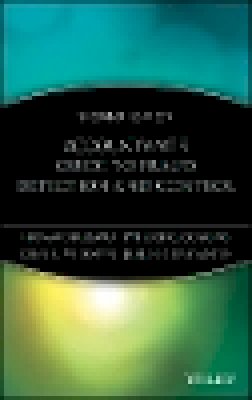
Stock image for illustration purposes only - book cover, edition or condition may vary.
Accountant's Guide to Fraud Detection and Control
Howard R. Davia
€ 171.78
FREE Delivery in Ireland
Description for Accountant's Guide to Fraud Detection and Control
Hardcover. The US Chamber of Commerce estimates that the cost of employee and management fraud exceeds $100 billion annually. In most cases, fraud is discovered completely by accident, the perpetrator does not get convicted, and the losses are not recovered. The authors estimate that only about 20% of all fraud gets discovered at all. Num Pages: 384 pages, black & white illustrations. BIC Classification: JKVC; KFCM; KJM. Category: (P) Professional & Vocational. Dimension: 243 x 166 x 26. Weight in Grams: 710.
From internal control structures that are not fraud-specific toinsufficient communication in the fraud discovery-to-investigationand conviction process, fraudulent activity is a widespread fact oflife in the business world. Historically, the corporate tendencyhas been to react to fraud after the fact, rather than to beproactive in its prevention. And in most cases, blame is directedat accountants and auditors. Unfortunately, these officers arerarely provided with the resources, proper training, and commitmentfrom top management that are essential to effective fraud detectionand control. The Accountant s Guide to Fraud Detection and Controloffers comprehensive direction for this largely unchartedarea.
Two types of fraud are addressed in this book: fraudulent financialreporting, also known as "Treadway" fraud, usually originating inthe top management sector; and "asset-theft" fraud, the more commonand more costly type, likely to be practiced by virtually anyone,including outsiders. Treadway fraud is being adequately detected byindependent auditors (CPAs) in their annual audits. Asset-theftfraud is not being adequately detected by anyone, with very fewexceptions. From following clues to achieving a prosecution, hereis sound advice that accountants and auditors will findinvaluable.
Businesses lose over $100 billion a year to fraud. Only 20 percentis discovered. Who s to blame?
Accountants and internal auditors are often the scapegoats formanagement s insufficient fraud detection operations andguidelines. At last, here is comprehensive, intermediate trainingfor evaluating, devising, and installing fraud-specific internalcontrols, and for conducting proactive fraud-specific examinations.Including actual case studies, the authors show accountants andauditors how to:
* Anticipate problems and follow clues
* Successfully disclose fraud
* Compile the evidence necessary to prosecute acts of fraud
* Develop investigative techniques
* Create effective internal controls . . . and much more, to fillthe needs of this crucial area.
www.wiley.com/account ing
Two types of fraud are addressed in this book: fraudulent financialreporting, also known as "Treadway" fraud, usually originating inthe top management sector; and "asset-theft" fraud, the more commonand more costly type, likely to be practiced by virtually anyone,including outsiders. Treadway fraud is being adequately detected byindependent auditors (CPAs) in their annual audits. Asset-theftfraud is not being adequately detected by anyone, with very fewexceptions. From following clues to achieving a prosecution, hereis sound advice that accountants and auditors will findinvaluable.
Businesses lose over $100 billion a year to fraud. Only 20 percentis discovered. Who s to blame?
Accountants and internal auditors are often the scapegoats formanagement s insufficient fraud detection operations andguidelines. At last, here is comprehensive, intermediate trainingfor evaluating, devising, and installing fraud-specific internalcontrols, and for conducting proactive fraud-specific examinations.Including actual case studies, the authors show accountants andauditors how to:
* Anticipate problems and follow clues
* Successfully disclose fraud
* Compile the evidence necessary to prosecute acts of fraud
* Develop investigative techniques
* Create effective internal controls . . . and much more, to fillthe needs of this crucial area.
www.wiley.com/account ing
Product Details
Format
Hardback
Publication date
2000
Publisher
John Wiley and Sons Ltd United States
Number of pages
384
Condition
New
Number of Pages
384
Place of Publication
New York, United States
ISBN
9780471353782
SKU
V9780471353782
Shipping Time
Usually ships in 7 to 11 working days
Ref
99-50
About Howard R. Davia
Howard R. Davia, CPA, has over 30 years of experience ingovernment, industry, and public accounting. He was president andcofounder of Executive Education Series, Inc., and has taught andlectured widely on the subject of fraud detection andcontrol. Patrick C. Coggins, PhD, is the Dupont Endowed Chair Professor atStetson University and holds JD and PhD degrees in Administrationand Adult Development and Education. He has over 28 years ofexperience in governmental and public sector financial management,legal issues, organizational diagnosis, and income taxes. He haspublished books, articles, and papers nationally and has extensivelecturing and consulting experience. John C. Wideman, PhD, has over 28 years of experience in the civil,criminal, and military intelligence fields as an investigator atthe federal and state levels, and as a private practitioner. He hastaught investigative courses for the U.S. government and severalstate agencies, and is currently a practicing privateinvestigator. Joseph T. Kastantin, CPA, is a consultant, author, and assistantprofessor of accountancy at the University of Wisconsin--La Crosse.He is also a certified management accountant, and the author ofProfessional Accounting Practice Management and several articles onmanagement, business control, and taxation.
Reviews for Accountant's Guide to Fraud Detection and Control
"...I opened this book with anticipation and it did not disappoint! I found the book well presented and easy to read. It certainly provides plenty of food for thought."(Accounting Technician, August 2000)
